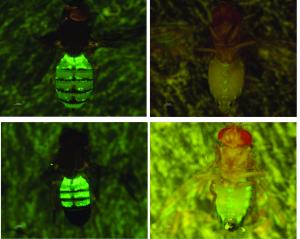UH VIDEO RELEASE: Genetic roots of insect’s waterproof coating could lead to innovative pest control
University of Hawaiʻi at MānoaUH Spokesman, Media Production
Joanne Yew, 808-956-5870
Assistant researcher , Pacific Biosciences Research Center

Wax-producing cells found on fly abdomen are labelled with green fluorescent protein. Spidey is essential for maintaining the health of these cells.
LINK TO VIDEO AND SOUND: http://bit.ly/29zqh2s
An international team of scientists led by University of Hawaiʻi at Mānoa researcher Joanne Yew may have discovered a new and effective way to control insect pests that are a threat to agriculture and humans. Yew and her team identified a gene in vinegar flies responsible for the insect’s waterproof coating, which provides them protection from microbes and environmental stress. They nicknamed the gene spidey and announced the findings in a recently published study in PLoS Genetics.
“When we knocked out spidey in adult flies, the flies exhibited several striking features: their lifespan was shortened by about 50 percent, they lost almost all of their waxy coating, and flies frequently got stuck to the sides of the plastic vials and were unable to free themselves,” said Yew, an assistant researcher based in the Pacific Biosciences Research Center of UH Mānoa’s School of Ocean and Earth Science and Technology.
“This last feature was reminiscent of the comic book character Spider-Man, which is why we named the gene spidey.”
Spidey is important for regulating levels of a steroid hormone, which maintains wax-producing cells. This hormone was already known to play a crucial role in the development and metamorphosis of fly larvae. The researchers did not expect that steroid hormones would play such a central role in maintaining adult tissues, such as the wax-producing cells.
“We did this work in vinegar flies, which is a major model organism,” said Yew, who grew up in Hawaiʻi and is a graduate of Maryknoll School. “From here, perhaps we can bridge to pest species.”
Yew and her colleagues now plan to knock out spidey in pest species like Oriental, Mediterranean and melon fruit flies, which are a major threat to agriculture, and possibly mosquitoes, which can carry human diseases, to see if they lose their waterproofing ability like the vinegar flies. She says it would be at least four more years of more research, testing and government approvals before the discovery could be used as a pest control.
This work was funded by the Singapore National Research Foundation, the UH Mānoa Office of the Vice Chancellor for Research and the UH Mānoa Pacific Biosciences Research Center.
LINK TO VIDEO AND SOUND: http://bit.ly/29zqh2s
BROLL (1 minute, 22 seconds):
- Yew working in lab with vinegar flies (9 shots)
- Stills of vinegar flies (5 shots)
SOUNDBITES:
Joanne Yew – Assistant researcher, UH Mānoa Pacific Biosciences Research Center (15 seconds)
“By knocking out this gene, we showed that the insects lost their waterproof ability and they ended up sticking to the sides of stuff and it was really difficult to get them off the sides of viles and they would often die that way because they couldn’t move.”
Yew (8 seconds)
“This presents an alternative solution to other methods currently used such as pesticides, which can be problematic.”
